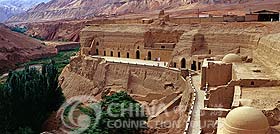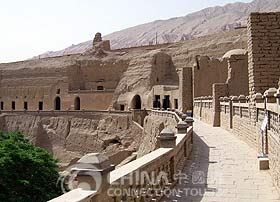
 The Bezeklik Thousand-Buddha Caves are situated on the cliffs of Mutougou Valley east of Turpan. During the 6th to 13th century, the caves were a Buddhist center. There are a total of 77 caves, 40 of which have murals including stories from "Buddhacari-takavysutra" and Mourning Buddhist Monks and Sakyamuni's disciples from "Nirvana", which are excellent works of rare art.
The Bezeklik Thousand-Buddha Caves are situated on the cliffs of Mutougou Valley east of Turpan. During the 6th to 13th century, the caves were a Buddhist center. There are a total of 77 caves, 40 of which have murals including stories from "Buddhacari-takavysutra" and Mourning Buddhist Monks and Sakyamuni's disciples from "Nirvana", which are excellent works of rare art.
Bezeklik means "place where there are paintings" in the Uigur language. Its most prosperous period was under the reign of the xizhou huigu government, which built the royal temple of the king of huigu on this site .most of the existing grottoes were extended or reconstructed during the huigu period.
 The caves are located in the cliff face of a long ridge of rather soft stone, which once had a monastery at its foot, an important center for Buddhist worship. A steep stairway lead 10m up to a narrow and winding path to the cliff top. The caves were built along this path.
The caves are located in the cliff face of a long ridge of rather soft stone, which once had a monastery at its foot, an important center for Buddhist worship. A steep stairway lead 10m up to a narrow and winding path to the cliff top. The caves were built along this path.
The caves are often rectangular rooms with a round arch ceiling. This ceiling is divided into quadratic fields, each of them containing the picture of a Buddha. So the whole ceiling contains virtually hundreds of Buddha. Although called a destroyer of paintings by some today, Albert von Le Coq and Theodore Bantus were the discoverers and conservers of the paintings. They discovered and explored the caves around 1905. It took half a century until the Chinese government started to protect the place by declaring it a cultural spot under State protection.

